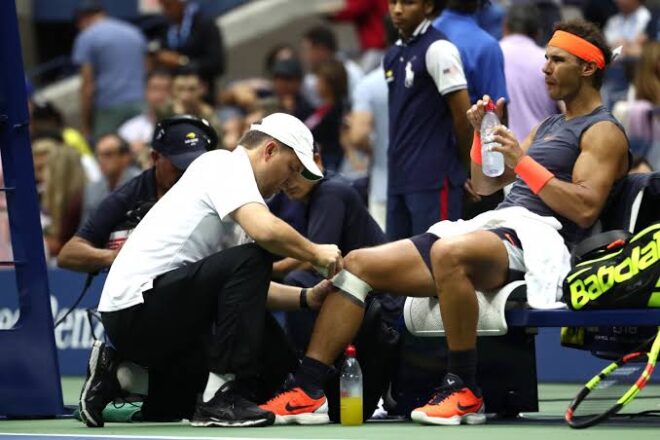
Rafael Nadal has faced multiple career-threatening injuries throughout his career, but one of the most significant was a persistent knee injury, specifically involving tendinitis. In the early 2000s, Nadal’s career was almost derailed by knee issues, which first surfaced in 2003. At that time, he suffered a stress fracture in his left ankle, but his problems with tendinitis in both knees began to plague him as his career progressed.

In 2005, when Nadal won his first French Open at the age of 19, he was already dealing with chronic pain due to his knees. This tendinitis would become a recurring issue throughout his career, leading him to miss several tournaments and seasons intermittently.
One of the most critical periods was in 2012, when Nadal had to withdraw from the season after Wimbledon due to Hoffa’s syndrome (inflammation of the fat pad in the knee), which caused extreme discomfort. This kept him out of competition for nearly seven months, causing many to question whether he would ever return to his top form.
Despite these injuries, Nadal’s resilience and adaptation in managing his body allowed him to return to top-level tennis. His ability to overcome these knee problems and make multiple comebacks is a testament to his physical and mental fortitude.
Rafael Nadal’s knee injuries have played a significant role in shaping his career, presenting major obstacles but also highlighting his perseverance and adaptability. His issues with patellar tendinitis, particularly in his left knee, started early on. Despite his rise to the top of the tennis world in the mid-2000s, Nadal’s knees became a recurring concern, often flaring up at key moments.
In 2009, after his historic first Australian Open win, Nadal’s knee tendinitis forced him to withdraw from Wimbledon. This was a huge blow, as Nadal was the defending champion and missing the prestigious event was a sign that his knee issues were becoming more severe. Following this, Nadal faced repeated struggles with his knees in the coming years, making it difficult for him to maintain consistent participation in tournaments.
In 2012, Nadal’s knee problems reached a new peak when he was diagnosed with Hoffa’s syndrome. This condition, involving inflammation and pain in the fat pad beneath the kneecap, forced him off the court after a second-round loss at Wimbledon. He missed the remainder of the 2012 season, including the Olympics, the US Open, and the ATP World Tour Finals. His seven-month absence led to speculation that his career could be at risk due to the ongoing knee issues.
Nadal’s return in 2013 was remarkable, as he dominated the season, winning the French Open and the US Open, among other titles, and reclaiming the world No. 1 ranking. However, the knee issues never truly disappeared. Nadal has had to adjust his playing style and training regimen to extend his career. He became more selective about the tournaments he played to manage his physical condition, often skipping certain hard-court events that put more strain on his knees.
In 2018 and 2019, Nadal continued to battle knee injuries but managed to win multiple Grand Slam titles. His strategy of taking extended breaks from the tour, focusing on physical therapy, and modifying his training helped him prolong his career. Despite the chronic nature of his knee problems, Nadal’s tenacity has allowed him to remain competitive at the highest level for more than a decade.